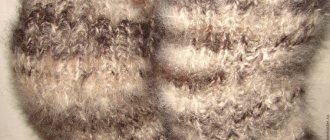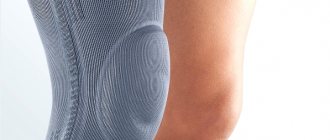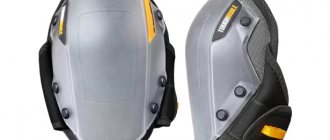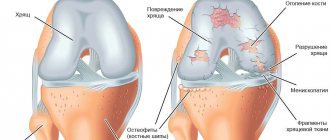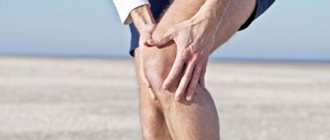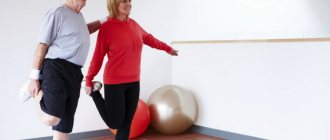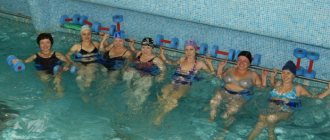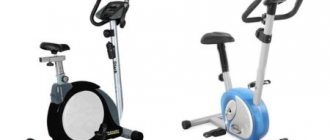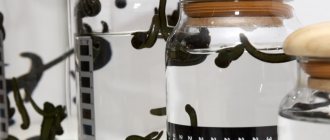As a result of many years of practice and research, it has been established that most often arthrosis of the knee joints develops as a result of constant heavy training and physical activity. Such intensive use of joints does not correspond to their strength and capabilities, which leads to premature aging and wear of cartilage and connective tissue. Special knee pads with the necessary force fix the knee in the anatomically correct position; in addition, they evenly distribute the load and provide a therapeutic effect.
The use of knee pads gives confidence to movements and reduces the intensity of pain. Let's talk about how to choose knee pads for arthrosis of the knee joint.
Rules for choosing knee pads
Therefore, when choosing, you need to consider the following criteria:
- Size selection. When choosing, you need to try on knee pads to accurately select your size. Typically, size parameters vary from 1 to 4. Small size, the first, is intended for thin athletes, and the fourth, on the contrary, for athletes of large build;
- Convenience. The knee pads should fit your knees perfectly. It is best to choose this remedy in the morning, since the legs swell after lunch. A knee brace worn on a leg should not cause a feeling of discomfort or tugging. If the slightest inconvenience arises, it is better to refrain from purchasing. The most convenient are devices with special Velcro holders. Thanks to these holders, they can be tightened or loosened;
- Quality. The more expensive the knee pads, the better quality they are. The most famous manufacturers do not use cheap material to produce these products. Therefore, in order to protect your knees well, it is best to pay a round sum;
- Material. It should provide good air penetration, warmth and comfort. In addition to this, it must be durable. For example, knee pads made of elastane or polyester are very wear-resistant, but have a high cost. Neoprene bandages are highly breathable. But devices made of cotton and wool warm well, but require additional care in the form of washing, and are not very durable.
In order to accurately determine the size of the knee pads, you need to perform the following steps:
- Measure the length of the lower leg from the middle of the kneecap to the foot;
- Measure the circumference of your leg 15 cm above the knee;
- Measure the circumference of your leg 15 cm below the knee.
The materials from which these devices are made are very diverse. Each type has its own characteristics. For example, cotton and wool provide excellent warmth, but require additional care. Synthetics are very wear-resistant, but do not allow air to pass through well.
The main materials from which knee pads are made and their features:
- Neoprene. The design of this material has high fixation. Also, thanks to compression, neoprene has warming properties. It is mainly used for the production of knee pads with easy fixation. However, when wearing devices made of this material for a long time, allergic reactions may occur;
- Elastane. It has the appearance of artificial yarn. It is mainly used in combination with various materials. Due to the fact that the design of this material has good elasticity and elasticity, excellent knee fixation is created. Elastane also allows air to pass through and therefore does not have a warming effect;
- Nylon. It is usually used to combine with other fabrics and fibers. It gives them strength and elasticity:
- Spandex. It is used in combination with other materials. Products made from this material have a good fit. Spandex is also highly breathable;
- Cotton. It is great for the skin, but has poor elasticity. Therefore, during the manufacture of knee pads, cotton is used in combination with synthetic elastic materials.
Good to know
When choosing a knee pad, you need to take into account the main factors: the size of the knee pad, its design features and the material from which it is made.
An incorrectly fitted knee brace can cause significant injury. Insufficient knee bracing may cause deterioration, increase the recovery period, and may not protect the knee from injury when used prophylactically. Too strong a fixation will weaken the natural muscle tone and impair blood circulation in the knee joint. Before buying an orthopedic knee brace, you should consult with a surgeon, orthopedist or traumatologist. Only a doctor should prescribe and select knee braces with a rigid degree of fixation.
There are five main types of knee pads with semi-rigid and light fixation, taking into account the features of their design. The design of the knee brace is compared with the characteristics of pain in the knee joint.
- A closed elastic knee brace
is used for pain in the knee joint, when determining the location of the pain is in doubt. This knee brace warms, creates a slight degree of fixation of the kneecap, they are often worn during fast walking and running.
- An open elastic knee brace with adjustable tension
is prescribed to patients who have undergone a rehabilitation course after ligament damage, have minor residual pain or fear of pain due to injury, and in addition, with pain due to arthritis.
- An open elastic knee brace with spiral stiffening ribs on the sides
is intended for patients who feel pain behind the kneecap while squatting or climbing stairs.
- an articulated knee brace
to a patient for pain associated with a healing knee injury, ligament rupture, meniscus damage, or in connection with surgery.
- The tendon support knee brace
is effective for pain in the area under the kneecap, as well as in the area of the knee tendon.
When choosing a knee pad, you should take into account the properties of the materials used to make it.
- Neoprene
holds the knee well due to compression and helps create a warming effect. Elastic knee pads with easy fixation are mainly made from this material. However, it can cause allergic reactions and is not recommended for patients to wear for long periods of time.
- Lycra (elastane)
is an artificial yarn characterized by increased elasticity and is used in combination with other fibers. Fixation of the knee is ensured by elasticity. Lycra is breathable. Does not have a warming effect.
- Nylon,
when combined with other fibers, gives the fabric strength and increases the life of the product.
- Spandex
is an elastic synthetic thread that is used in conjunction with other fibers. With its help, a perfect fit is achieved.
- Cotton
is known as a natural material that is ideal for the skin. Cotton itself is not an elastic material at all, so it is used in combination with synthetic fibers when making knee pads.
When choosing a knee pad by size, take into account the circumference of the entire knee along a line that runs through the center of the kneecap. To select a knee brace as accurately as possible, you need to grab your leg 15 centimeters above the knee and 15 centimeters below the knee and take the resulting measurements.
Examples of schemes for selecting the size of a knee pad:
How to forget about joint pain?
Knee pads vary in degree of rigidity and the material from which they are made. They come in open, closed and hinged types. There is a huge variety of these orthopedic products on the market.
Bandages are designed for soft fixation of the knee joint.
Used for mild arthrosis (slight stiffness in the joint, aching pain in the morning)
There are: 1. Simple, elastic - they are recommended for mild arthrosis and for its prevention.
- Elastic, adjustable - for easy fixation in the presence of slight pain or stiffness of movement.
- Elastic, with stiffening ribs - used for pain when walking up stairs, squatting, running.
Knee brace.
- this is the same knee brace, only with ribs for rigid fixation that does not interfere with physical activity. Used for moderate severity of the disease (crunching, pain during flexion-extension)
1. Elastic with rigid plates. Similar in design to bandages with stiffening ribs, the difference is in a more rigid fixation.
2. Hinged and mixed - provide moderate movements in the knee joint. Prescribed after injuries and knee surgeries.
— made of rigid material with the addition of rigid ribs and the ability to adjust.
Special.
- Heated - with an infrared or halogen lamp for uniform heating of the joint. Quickly relieve inflammation and swelling. They are used for chronic forms of arthrosis and to relieve acute pain.
- Made from animal wool (sheep, dog, camel). They protect against hypothermia and perform a healing function.
- Magnetic - orthoses with magnetic stiffeners. Magnetic fields have a beneficial effect on all components of the joint. To some extent they can replace magnetic therapy.
- made from natural materials such as wool and cotton. They warm well and are comfortable to wear, but due to the need to wash them frequently, they wear out quickly.
- made of nylon, wear-resistant, but if worn frequently it can cause redness and inflammation of the skin.
- made of neoprene. They have a pronounced warming effect. Elastic and durable, but can also cause skin irritation. It is recommended to place natural fabric under products made of nylon and neoprene.
- made of elastane (elastin, polyester). Hypoallergenic material, durable and elastic. Fixes the knees well due to its tight fit. Do not interfere with air circulation.
During manufacturing, the mineral tourmaline is often added to the material, which emits weak electromagnetic radiation that has a beneficial effect on all tissues.
- Joint pain limits your movements and full life...
- You are worried about discomfort, crunching and systematic pain...
- You may have tried a bunch of medications, creams and ointments...
- But judging by the fact that you are reading these lines, they did not help you much...
Materials
Modern industry produces at least 5 types of synthetic and natural fabrics. Typically, the following materials are used in the manufacture of splints:
- Cotton. Plant fibers found on top of cotton seeds are used as raw materials. The fabric absorbs moisture well, up to 40% of the volume. When wet, strength increases by 15%. But there is a big disadvantage - poor wear resistance. After 5-10 washes the product will lose its shape.
- Spandex. The base is a thread made of polyurethane rubber. Already from the description it is clear that the fabric has high elasticity. Reminds me of rubber. It fits tightly around the joints and provides a secure fit. This is a type of lycra with similar properties.
- Neoprene. One type of synthetic rubber. Appeared on the market thanks to the American one. Wetsuits are made from it. It warms the joints perfectly, but does not allow air to pass through or absorb water. There is a risk of skin irritation.
- Nylon. It is also called nylon or anid. Consists of plastic threads. It stretches with difficulty. But it is very durable. The basis was developed by the same chemists from the USA, working at the DuPont factory back in 1938.
Inexpensive soft knee pads for sports are made from polyester.
How to choose knee pads for volleyball and how to wash them
A knee brace is a special orthopedic device whose task is to support the knee joint. They provide fixation and some stabilization of the knee and patella, support the collateral ligaments and menisci.
Indications for the use of knee pads are:
- rehabilitation period after operations and injuries;
- prevention of knee injuries during sports;
- for various diseases such as arthrosis, arthritis, synovitis, bursitis, etc.
- with heavy loads on the knee joint in everyday life;
- for “loose” joints, in which patients complain of a feeling of knee instability when walking.
Materials from which knee pads are made
- Cotton. This natural material allows the skin to breathe while being soft and comfortable to wear. However, such sports knee pads have low wear resistance and cannot provide the necessary fixation without the use of additional splints. They can be worn on the body for a long time without fear of irritation and diaper rash.
- Lycra. These sports knee pads are very resilient and elastic, while allowing the skin to breathe.
- Neoprene. Knee pads made of this material do not allow moisture and air to pass through, so wearing them for a long time is not recommended. They have a compression, warming effect and can be used when practicing water sports.
- Nylon. Knee pads made of this material are distinguished by their strength and durability, which ensures the longest service life. This is reflected in the price of products, which is usually higher than average.
- Spandex. This material ensures that the knee pads fit snugly around the knee and securely fix it.
Choosing a knee pad depending on the type of sport
- For acrobatics and sports dancing, models of sports knee pads with thick soft pads are suitable.
- For volleyball, preference is most often given to models with gel inserts, which over time take on the shape of the knee and provide soft protection, reducing the risk of injury and softening the blows in the event of a fall. The same knee pads are also popular for skating, roller skating, and skateboarding, and can also be used for preventive purposes in almost all sports and in everyday life.
- Neoprene knee pads are purchased for water sports.
- Hockey requires rigid and durable knee pads that can protect the knee from injury from impacts and falls.
- There are also dance knee pads. They provide soft and reliable support for the knee, while being practically not felt on the leg and do not interfere with performing dance steps.
- For playing handball, football, basketball and other aggressive games, knee pads with reinforced stitched pads are used, which will protect the joint from falls and impacts to the knees.
- There are separate knee pads of different sizes for children. They help protect children's knees during sports, as well as during active leisure.
- There are also universal knee pads that can be used for any sports activities and for wearing in everyday life for preventive purposes. They have a thin and wide insert, which is produced using a special technology and softens shocks well. Due to their small thickness, such knee pads are practically invisible under clothing.
How to determine knee pad size
No knee brace will help you if the size was initially chosen incorrectly. Each company produces its own knee pad sizes, so you need to choose individually each time. The box with the product always contains information with a size scale.
Usually, to determine it, it is enough to measure the circumference of the knee joint in the center of the kneecap in a standing position and compare it with the scale, choosing the appropriate one.
httpv://www.youtube.com/watch?v=embed/4qxCY7K5AsQ
Sometimes additional measurements of the lower leg and thigh are required. In any case, an orthopedic doctor or sales consultants will always be able to help determine the correct size.
Contraindications to wearing knee pads
There are practically no contraindications to the use of these orthopedic devices. Relative contraindications are:
- allergies caused by the material of the knee pad;
- thrombophlebitis;
- inflammation and violation of the integrity of the skin where the knee pad is worn;
- purulent inflammation of the joint and in cases of contraindications to thermal procedures.
In any case, before purchasing a knee brace, you need to visit an orthopedic doctor, who will help you decide on the appropriate knee brace model and confirm the need for it.
Main qualities of fasteners
The following are the important healing properties of knee braces:
- Providing a warming effect on the knee. Most often, when making orthopedic bandages, manufacturers use animal hair as a layer. The warming properties of natural material create a healing effect by improving blood circulation.
- Correct fixation of joints. Orthopedic knee pads for arthrosis can reduce the load on ligaments and joints, and also slow down the development of the disease. However, these results can only be obtained with the correct size.
- Prevention of injury. Knee injuries are not uncommon when playing sports. If you use medical orthopedic braces, you can provide additional protection to your joints.
Knee pads for arthrosis: how to choose the right one
To date, there is no medicine that could quickly and completely cure arthrosis. But there are a number of measures that can significantly improve a person’s condition and quality of life. The main factors that cause this disease still remain unknown. But everyone knows the side effects that provoke the onset and exacerbation of the disease. These include: increased loads, uncomfortable shoes, genetic characteristics, results of injuries, etc.
- How to choose knee pads for arthrosis
- Reviews
For treatment, it is better to carry out a set of procedures: taking special medications, therapeutic exercises, physiotherapy, and orthopedic products (knee pads, etc.) to help the joint. Arthrosis is the most common, since the musculoskeletal system bears the entire load. At the first signs, you need to contact a specialist in order to start treatment in a timely manner.
Arthrosis is divided into stages:
- initial – when tumors and pain in the knee joint appear only in the morning;
- the second – with more significant pain during movements, a characteristic crunch may appear, without timely treatment, fluid accumulation and deformation of the joint occurs;
- the third is the most painful, with it the deformation becomes visible and the gait is disturbed.
How to choose knee pads for arthrosis
If you contact a specialist when the first signs of arthrosis appear, he will be able to quickly determine the extent of the disease. In accordance with this, he will recommend medications and auxiliary procedures aimed at improving the general condition and eliminating the disease. Chondroprotectors are usually prescribed as medications, which are made from natural ingredients - animal cartilage tissue or crustacean shells.
The main quality of the drugs in this group is that they are absolutely harmless to the body and perfectly restore cartilage tissue and joint function. Their treatment lasts on average 3 months. If the disease is already in the second or even third stage, the doctor may prescribe steroid injections into the joint. They help relieve inflammation and relieve pain.
For effectiveness, taking into account individual characteristics, physiotherapy procedures are prescribed. It is at this time that the joints need rest or reduced load. To do this, the doctor will prescribe the use of a cane or special knee pads for arthrosis of the knee joint. With the help of the latter, you can significantly relieve pain, swelling, limited joint mobility, and poor circulation. A specialist can tell you how to choose the right knee pads for arthrosis, taking into account all the features and stage of the disease.
The following types of knee pads are distinguished:
- Closed elastic - to relieve pain when the localization is still impossible to determine. They provide easy fixation and warming of the joint;
- Open elastic with adjustable tension fastener - for the postoperative period and with minor pain;
- Open elastic knee pads with spiral ribs for rigid fixation – for pain behind the kneecap, which occurs when walking up stairs;
- Hinged knee pads – after injuries and surgery;
- Knee pads for tendon support – for pain in the kneecap and its area.
For accuracy, you need to know the individual size of the knee joint circumference. In addition, a special place in the choice is occupied by what material the knee pad is made of. Experts always recommend choosing natural ones that allow air to pass through and moisture to be expelled.
This is the only way to avoid irritation and various allergic rashes. For knee pads for arthrosis, reviews agreed on the optimal composition. It must include neoprene, elastane, spandex and/or cotton.
On the advisability of using knee pads
Gonarthrosis develops as a result of injuries and degenerative processes in the structures that form the knee. The fixator secures the knee joint and reduces surface friction. As a result, metabolic processes are normalized, blood flow is activated, degenerative processes and joint aging are slowed down.
The main principle of treatment of any bone tissue pathologies is immobilization of the deformed area. Thanks to this, any damage can be restored. In the case of damage to the knee joint, the use of a special orthopedic device is especially important, since any connecting formations in the knee area have a weak ability to regenerate.
The period of wearing knee pads for arthrosis is quite long, since the pathology of the knee joint most often transforms into a chronic form.
Any fixation devices should preserve the functionality of the knee joint as much as possible. Rigid dressings do not meet these requirements and cannot be used for a long time. The use of conventional elastic bandages is also not effective enough, here are the main disadvantages:
- It is difficult to apply the bandage absolutely correctly;
- As a rule, the elastic bandage does not fit well and needs to be adjusted frequently;
- With such a bandage, mobility is impaired;
- In addition to the knee, soft tissues are strongly compressed, resulting in swelling of the lower leg and foot.
Knee braces do not have such disadvantages, they can be used at any stage of pathology, they are comfortable, and do not affect the functionality of the knee.
Magnetic and mineral knee pads for gonarthrosis
These fixatives are classified as warming medical products. The magnetic field and mineral core improve blood circulation in the joint area, reduce pain, and help improve the trophism of periarticular tissues. Tourmaline, magnetic or tourmaline-magnetic knee pads have these qualities.
The calipers have the following contraindications:
- manifestations of skin diseases in the knee area;
- violation of the integrity of the epidermis or loss of its sensitivity in the area of \u200b\u200bthe articulation;
- body temperature is more than 37° C.
The time of use of the products should be increased gradually. At first, you walk in these knee pads for no more than 15 minutes, 2 times a week. The skin under the product sometimes turns red, and tingling and burning sensations appear. These phenomena are the result of the combined influence of the mineral and the magnetic field. The skin reaction disappears within 6 hours after removing the caliper.
After a month, if well tolerated, tourmaline magnetic products can be worn for a longer time. If, after starting to use them, you feel unwell, or complications arise from the periarticular tissues, you should stop wearing the support, and also consult a doctor for medical help.
Care
Simple thin knee pads without additional fixing elements quickly lose their performance. Only a few of them survive to the first wash. But high-quality calipers can keep their shape for 6-10 months. During this time, the fabric will become saturated with sweat and collect dirt more than once. It needs to be cleaned.
Wash
At least once every 2 weeks, knee pads need to undergo “water procedures”. Only plastic models, such as skateboarding guards, do not need this. Other models must be washed by hand at a water temperature of 30-40 degrees Celsius. Cars cannot be used. The drum can damage the fittings, fabric and softening inserts.
It is better to avoid using caustic chemicals. Bleach and stain remover will do more harm than good. Liquid detergent is the ideal choice. Popular brands are Synergetic, Ariel and Nordland.
Drying
After cleaning, sports knee pads must be dried thoroughly. It is better to keep calipers away from heaters, batteries and open sunlight. Too rapid evaporation of moisture can cause changes in the structure of the fabric fibers. It doesn't matter whether it's synthetic or cotton. There will be a risk of deformation.
The ideal place for drying would be an ordinary room with a temperature of 22-24 degrees Celsius. The supports can be placed on a regular clothesline. Preferably away from the kitchen. Artificial and natural materials perfectly absorb foreign odors. It will be difficult to get rid of the “aroma”.
Articular space of the knee joint
As usual, the joint space of the knee joint tends to narrow in diseases such as gonarthrosis and osteoarthritis of the knee.
Studies have shown that this leads to even faster and more extensive wear of the cartilage, a decrease in the firmness and elasticity of cartilage tissue, as well as its gradual destruction. In conjunction with the above processes, deformation and restructuring of the bone tissue of the knee joint occurs. The formation of spines occurs, limiting motor functions in the human body. Movement is limited, and the patient experiences severe pain. If concomitant diseases are not treated, an irreversible pathological process may develop. There will be complete destruction of cartilage tissue, exposure of bones, formation of spines and deformation.
To check for joint diseases, you need a picture of a normal joint. According to laboratory data, the norm for the joint space of the knee joint is 6-8 mm in the lateral meniscus, 4-6 mm in the medial meniscus, 2-2.5 mm in the metatarsophalangeal joints.
So, how to determine a high-quality x-ray:
- Both condyle blocks of the femur, or rather their axial sides, must be symmetrical;
- The intercondylar eminences should be located in the center of the intercondylar fossa;
- Possibility of examining the patella femoral joint and the tubercles of the tibia;
- The contours of the patella are superimposed on the central part of the metaepiphysis of the femur;
- Partial masking of the head at the fibula by the metaepiphysis of the tibia (at a ratio of 1/3 of the transverse size);
At a distance from the surfaces of the bones, an x-ray shows the joint space, called an x-ray. It bears this name because it is visible only on x-rays - in the form of a translucent strip between the surfaces, as it is filled with cartilage and interlayer.
The contours of the X-ray slit, internal and external, have different curvatures in direct and projection. That is why they cannot be recognized - as a perfectly smooth and solid line in one picture. The image, which was taken under conditions of maximum knee extension, is considered standardized for the anterior and posterior projections. It makes it possible to conduct research in the anterior region of the joint gap.
Frontal photographs taken at angles of 30° (Schuss position) or 45° (Fick position) are taken to assess the condition of the posterior region. At this level, in most cases, damage to the bones of the subchondral region is detected, the so-called osteonecrosis, as well as damage to cartilaginous structures - osteochondritis.
This type of placement of the knee cup makes it possible to detect loose foreign bodies in the articular cavity, which are formed as a result of damage to cartilage and tissue.
How to make the right purchase
Even “advanced” joint problems can be cured at home! Just remember to apply this once a day.
The answer to the question: how to choose knee pads for arthrosis of the knee joint is very simple. Firstly, it is best to determine the type of product that is right for you, and secondly, as mentioned above, choose the right size.
To choose the right model that can be most effective, we advise you to study all existing types of knee pads:
- The open form is intended for people experiencing pain due to arthrosis in a certain place after injury, as well as mild pain. It has special fastenings for reliable and correct fixation.
- Open elastic knee pads with extreme ribs. This type is suitable for patients who complain of knee pain during squats and when climbing stairs.
- The open form with adjustable tension allows the patient to make life easier during the post-rehabilitation period.
- The closed form is designed for use when the source of pain is unclear, i.e. pain in more than one specific location. Maximum reduces the load on the joint, including 15 cm on each side.
- The magnetic type differs from the others in that it has a built-in magnet inside it, which creates a magnetic field that improves blood circulation and also has a warming effect.
- The type that supports the tendons is necessary for use for pain under the knee, because it provides fixation not only to the tendons.
- The hinged form is recognized as the most universal: it is created to prevent pain after injury (for example, rupture of ligaments) and with arthrosis that deforms the joints. You can choose this form because of its main feature - the possibility of slight bending of the knee.
- The warming type is equipped with a special infrared lamp, which is built into the knee pad and allows the area most susceptible to pain to be heated.
Read also: Neck collar for osteochondrosis
Treatment with knee braces can only be prescribed by an orthopedic doctor. The specialist will take into account your individual characteristics (knee girth, disease) and help you choose the material and type of product.
How to find out your knee pad size
Each company produces clamps according to the size range, which corresponds to the classification accepted in a given country
Please also pay attention to the unit of measurement. The size can be indicated in centimeters or inches
On store shelves there are knee pads, the sizes of which are marked as follows:
- letters S, L, JR, M, SR, XL, XXS, XXL, XS, 3XL;
- Arabic or Roman numerals from 1 to 18, I–VII;
- words Small, Medium, Lagre;
Each product corresponds to a specific joint circumference. To determine your size, stand up straight and ask someone to measure with a centimeter the circumference of your knees in the center of the joint, as well as the leg above and below the joint by 5-15 cm. The height should be measured along the inside of the shin and thigh from the horizontal line passing through the center of the joints .
What types of knee pads are there?
Knee pads vary in degree of rigidity and the material from which they are made. They come in open, closed and hinged types. There is a huge variety of these orthopedic products on the market.
Let's look at the most common of them.
Elastic knee bandage.
Bandages are designed for soft fixation of the knee joint.
Used for mild arthrosis (slight stiffness in the joint, aching pain in the morning)
- Elastic, adjustable - for easy fixation in the presence of slight pain or stiffness of movement.
- Elastic, with stiffening ribs - used for pain when walking up stairs, squatting, running.
Knee brace.
- this is the same knee brace, only with ribs for rigid fixation that does not interfere with physical activity. Used for moderate severity of the disease (crunching, pain during flexion-extension)
1. Elastic with rigid plates. Similar in design to bandages with stiffening ribs, the difference is in a more rigid fixation.
2. Hinged and mixed - provide moderate movements in the knee joint. Prescribed after injuries and knee surgeries.
Splints for the knee joint.
— made of rigid material with the addition of rigid ribs and the ability to adjust.
They are used for exacerbations of arthrosis, for persistent pain, after surgery and after injuries.
Special.
- Heated - with an infrared or halogen lamp for uniform heating of the joint. Quickly relieve inflammation and swelling. They are used for chronic forms of arthrosis and to relieve acute pain.
- Made from animal wool (sheep, dog, camel). They protect against hypothermia and perform a healing function.
- Magnetic - orthoses with magnetic stiffeners. Magnetic fields have a beneficial effect on all components of the joint. To some extent they can replace magnetic therapy.
How to choose based on material of manufacture.
- made from natural materials such as wool and cotton. They warm well and are comfortable to wear, but due to the need to wash them frequently, they wear out quickly.
- made of nylon, wear-resistant, but if worn frequently it can cause redness and inflammation of the skin.
- made of neoprene. They have a pronounced warming effect. Elastic and durable, but can also cause skin irritation. It is recommended to place natural fabric under products made of nylon and neoprene.
- made of elastane (elastin, polyester). Hypoallergenic material, durable and elastic. Fixes the knees well due to its tight fit. Do not interfere with air circulation.
During manufacturing, the mineral tourmaline is often added to the material, which emits weak electromagnetic radiation that has a beneficial effect on all tissues.
Which orthosis should I choose based on the degree of rigidity?
Rigid and semi-rigid models are available. The product is selected taking into account the severity of the injury or disease, taking into account the stage of treatment and the requirements for fixation. In case of injury, it is recommended to choose a hard knee brace. It is indicated for sprains, fractures, dislocations.
Easy fixation
The products do not have stiffeners. They create compression and limit movement by a third. The indication for wearing is the prevention of injuries arising from physical activity. The product is worn to speed up the recovery process in case of sprains and inflammation, at the final stage of the post-traumatic or postoperative period. Prescribed for bursitis, pain, arthrosis, synovitis, exacerbation of arthrosis. For example, in our store, in this case, the knee joint fixator “Elast 9903” is suitable.
Semi-rigid fixation
Knee pads have spokes, tires, and stiffeners. They provide unloading and support, limiting movements by half. Products are indicated for joint instability, diseases, damage to the meniscus and ligaments, and for the prevention of sports injuries.
Maximum fixation
The models have stiffening ribs and additional elements. Orthoses limit movement by two-thirds or until complete immobilization. It is prescribed to be worn if complete immobilization of the joint is necessary. They do not allow mobility in certain directions. An excellent option in this case is the knee joint limiter MPE 12003. The product is indicated for severe injuries, after operations, for osteochondropathy, and osteoporosis.
If the fixation is insufficient, problems with the joint may worsen and the rehabilitation time will be delayed. On the contrary, excessively strong fixation impairs blood circulation and reduces muscle tone. To make the right choice, it is important to consult a specialist.
Which knee brace to choose for arthrosis of the knee joint
You need to carefully consider purchasing the product, because... An incorrectly fitted knee brace can compress blood vessels, impair blood flow in the affected area, or weaken muscle tone.
When choosing the type of knee brace, you should pay attention to the nature of the pain syndrome:
1. If the pain is severe enough and occurs when raising the leg, then you should choose a product with enhanced fixation.
2. If the pain is of uncertain localization, then a closed-type knee brace is suitable.
3. For minor pain or during the post-injury period, it is better to choose an open type knee brace.
4. If you need a universal knee brace for any stage of arthrosis, then it is better to choose a hinged type.
The fabric must be pleasant and breathable, otherwise the natural circulation of moisture and air will be disrupted. If natural materials are needed, then it is better to choose a product made of cotton or wool, but they have several disadvantages: rapid wear, wet processing is permissible at a temperature not exceeding 40°C. If you need a more wear-resistant material, then it is better to choose synthetic knee pads (with the addition of lycra, elastane, nylon, polyester, etc.). Such products have less breathability, but a greater warming effect and convenient operation.
To choose the right size, it is necessary to feel a tight, uniform fit. A knee brace that is worn loosely, as well as an excessively compressive one, will not bring the expected beneficial effect.
To understand what size is needed, you should measure your knee circumference:
1. XL – 45-50 cm.
2. L – 40-45 cm.
3. M – 35-40 cm.
4. S – up to 35 cm.
The product should securely secure the joint area. Bleeding at the fixation site should not be disturbed. It is advisable to purchase the product with preliminary fitting, i.e. You can estimate how convenient it will be to use it for several hours a day.
You need to choose a knee brace according to the degree of fixation based on the stage of the disease: at the initial stage (stiffness in movement in the joints, especially in the morning), soft fixation is suitable; on the average (crunching in the joints, increasing pain, limitation in flexion/extension) - semi-rigid; on severe (almost lost mobility, constant pain) – hard.
Athletes who are exposed to regular training or people with heavy physical work need additional knee protection. Therefore, it is recommended to purchase preventive closed knee pads that prevent damage to the knee cap and joints.
Contraindications
There are diseases that serve as an obstacle to the use of orthoses. Here is their list:
- Osteoarthritis. This is deforming arthrosis. In the United States, it affects up to 7% of the total population. Bone tissue becomes fragile, so external influences can be harmful.
- Thrombophlebitis. Inflammation of the venous walls. The tissues swell and any pressure will only worsen the course of the disease and intensify the symptoms.
- Varicose veins According to the results of a 2004 study in Moscow, a similar diagnosis was found in 67% of women and 50% of men.
- Allergy. Protective knee pads for sports are made of cotton and synthetic materials. The latter can cause skin rashes.
Open wounds at the site where the caliper is installed are a clear reason for refusing to use an orthopedic device. There are other risk factors. For example, eczema or dermatosis.
Kinds
Types of knee pads vary depending on the purpose for which they are used. So, for severe traumatic injuries, doctors may recommend rigid or semi-rigid products. And in case of exacerbation of arthrosis, even a regular elastic bandage may be sufficient.
Knee pads are a wide variety of products. This includes not only orthopedic, but also protective models. Which are usually polyurethane or gel.
Elastic
Elastic fabric knee pads are quite versatile. Suitable for many occasions and not too dependent on the size chart. Medical products of this type are quite soft and provide, albeit minimal, skin breathing.
Suitable for pain and mild sprains. And also for long-term rehabilitation of nearby tissues in the meniscus in case of its rupture. They are inexpensive, it is easy to find a product made from natural fabrics.
It has a slight warming effect, so it will also help with joint inflammation. And having bought such a fixative once during an exacerbation of the disease, you can then use it in training for prevention.
Elastic models are also available with connectors for the most convex point of the knee. Detachable (or, also called, open) products are more comfortable to wear.
Compression
Compression knee pads are designed to provide moderate support to the joint. Reduces swelling and helps fight inflammation. Often used after endoprosthetics to make it easier to get used to the implant. Supports the knee structures more than an elastic bandage. Therefore, when choosing, you need to be guided by your own feelings and how badly your knee is damaged.
Neoprene
A neoprene fixation product will last you for many months, and possibly years. This is a very durable material.
Ideal for meniscus damage, as well as after other injuries. The fixation turns out to be quite rigid. Sometimes it is supplemented with additional supporting parts - hinges or stiffeners.
However, neoprene is a non-breathable material. Wearing knee pads will make your leg sweat a lot and it will be hot. Yes, and there is a risk of getting tired faster from such a well-fitting, dense material.
Articulated
Hinged knee braces are also called orthoses. They provide the most rigid support for the joint position. In addition to the fact that devices with hinges relieve stress, they also prevent sudden movements.
In some devices, you can adjust the stiffness of the hinge. This way, as you recover, you can relax the device and give yourself more freedom of movement. Most often, articulated orthopedic products are used in the first stages after surgery. Or after complicated injuries, including a meniscus tear.
Fixing
The knee brace usually uses thick fabric. As well as tapes that help secure the position of the product on the knee.
Unlike elastic models, fixing knee pads are aimed at reducing the load as much as possible. And at the same time, do not burden the patient’s life with plastic parts such as stiffeners and hinges.
With stiffening ribs
Orthopedic knee pads with stiffening ribs resemble elastic models. However, they use several plastic or metal parts to provide rigidity.
Therefore, such a product will be a solution if you need strong fixation, but there is no way to wear an articulated model. Often prescribed to older people.
Semi-rigid
They are made of elastic material, but are equipped with dense strips of Velcro. They allow you to maintain greater mobility and at the same time protect the joint from damage.
Often used by weightlifters and athletes. They are easy to put on before training and take off after the leg exercises are completed. They are convenient because they do not need to be put on before each approach.
Universal
Most modern models use size adjustments. They are usually made in the form of adjusting tapes or Velcro.
Therefore, the question of how to determine the size of the desired product is now rarely asked. In most cases, you can decide with your doctor which products are best suited without looking at their sizes.
Varieties
Manufacturers of knee pads for knee joints with arthrosis make various designs. First of all, they differ in their structure.
Open braces have a hole in the kneecap area, however, they firmly fix the elements of the knee joint. This type of brace is recommended for patients with mild pain, as well as for those who have developed osteoarthritis after receiving a traumatic injury, and the process is not widely used. The knee pad is tightly fixed on the leg, and the hole allows you to feel comfortable when bending the knee joint.
An open design with stiffening ribs is a knee brace that has stiffening ribs sewn into the sides, made of metal plates that protect the knee joint. Knee pads are recommended for people who find it painful to squat or climb stairs. Often such knee pads are used by athletes who have arthrosis of the knee joint as an occupational disease.
An open knee brace with adjustable fixation force is an ideal design for patients who have undergone surgery on the knee joint, such as endoprosthetics, as well as for patients with arthrosis in the early stages. The knee brace allows you to adjust the degree of tension of the clamp, so wearing it is more comfortable, either loosening it or tightening it if necessary.
Closed knee pads are used for extensive arthrosis of the joints, when not only the articular surfaces are affected, but there are also associated injuries, for example, sprains, inflammatory processes in the joint. These knee pads take the maximum load off the sore knee joint.
The action of a closed knee brace with stiffening ribs is similar to an open one, but in this case it provides greater fixation. This is important for those patients who have long suffered from arthrosis and often injure the knee joint. It is recommended to wear it for additional fixation of tendons.
Hinged knee braces are considered by many doctors to be the best knee braces because they can be modified to accommodate many types of knee injuries. With such a knee brace, you can adjust the level of knee flexion during moments of exacerbation of arthrosis, provide complete blocking of flexion if immobilization is necessary after an injury, etc.
Warming therapeutic knee braces are recommended for patients with chronic knee pain, since the pain is eliminated by warming. Heating is carried out from batteries. The operating time varies depending on the design, but on average, the knee pad provides a warming effect for about four hours.
How to choose a knee pad size.
To achieve a therapeutic effect for arthrosis, it is necessary to choose the correct size of knee pads. The fact is that if you don’t tighten it tightly enough, you won’t get the desired result, and if you tighten it, you risk blocking the access of blood to the vessels and causing numbness in the limb.
Size of knee pads depending on the circumference of the knee joint
| Size | Knee joint circumference, cm |
| Small (S) | from 30 to 36 |
| Medium (M) | from 36 to 40 |
| Large (L) | from 40 to 45 |
| Extra Large (XL) | from 45 to 49 |
When using orthopedic braces, a person suffering from arthrosis can hope for a reduction in discomfort and a therapeutic effect. Typically, as you wear orthopedic braces, you will notice the following improvements:
- reduction of the inflammatory process in diseased joints;
- gradual reduction of pain;
- absence of swelling, edema;
- reducing pressure on joints;
- improving blood circulation in affected areas;
- stabilization of the musculoskeletal system.
The question of buying knee pads is very relevant among people experiencing discomfort in their joints. The price for this product varies from region to region, depending on the type of product. The simplest of them are priced at around 1,000 rubles, while more expensive ones (for example, hinged type) can have a price from 3,000 to 25,000 rubles.
You can buy a knee brace in pharmacies or special orthopedic stores.
The knee pad should not pinch the knee to avoid circulatory problems.
Too weak and will not bring any therapeutic effect. To determine the size, you need to measure your leg 15 centimeters above and below the kneecap and then calculate the arithmetic average (you can simply measure the volume in the area of the kneecap).
In the Russian Federation, the following size scale is accepted: S = 30-35 cm; M = 36-39 cm; L = 40-44 cm; XL = 45-49 cm.
The knee brace should be used individually, depending on the degree of arthrosis. The duration and daily duration of wear must be agreed with the attending physician. But be sure to use the product during physical activity and severe pain.
It is recommended to wash knee pads by hand in warm water with products that do not contain chlorine. It is better to dry away from heating devices.
We hope this article helped you choose the right product.
What are knee pads, effectiveness of use
Therapeutic knee braces are orthopedic devices that are placed on the knees in order to give them the correct anatomical shape and position. They are used to make walking easier and slow the progression of pathology.
There are several types of knee braces; they are selected depending on the type and form of the pathology. Four criteria influence the choice:
- Intensity of pain syndrome;
- Location of discomfort;
- The degree of damage to the knee joint;
- Skin sensitivity to certain materials.
An orthopedist or rheumatologist must take part in choosing a knee brace.
Types of knee pads and their features
This type of knee pads is very often used while cycling. The knees in such knee pads will always be protected from injuries that can lead to serious damage, including fractures.
Depending on the design, this type of knee pads can be divided into the following groups:
- Tough. These drugs are used for therapeutic purposes. The internal structure has special hinges that effectively fix the knee. Knee pads that cover the area from the hip to the ankle provide good relief from the knee joint. The knees are immobilized and due to this there is no pain when walking;
- Semi-rigid. The design has side rails and additional reinforcements. This ensures reliable fastening of the knees and reduces the risk of damage to the lateral ligaments. This group mainly includes knee pads, the design of which has an open cup.
- Soft knee pads. These products are mainly used for active sports. The design is made of elastic material. Thanks to this property, you can move freely, and there is no danger that the kneecap will be damaged or injured during sudden movements. The elastic material completely encloses the knee joint and does not allow it to sway or move during movement. These models have warming and massage properties. Due to this, they are mainly used while running;
These products have warming properties. Very often they are used during diseases of the knee joints.
Warming knee pads come in the following types:
- With halogen lamp. Due to this, good warming of the knees is ensured. Also, while wearing these knee pads, there is no pain;
- Knee pads with magnetic structure. These products perfectly relieve overload from muscles and ligaments. They also ensure uniform heat distribution and increase blood circulation;
- Mineral knee pads. These models are made of mineral material containing tourmaline. Tourmaline has good warming properties. It provides deep penetration of heat, normalizes blood circulation and restores cells. Basically, knee pads made of this material are used for deep damage to the cartilage of the knees.
These products have warming properties. They are mainly used during knee diseases and injuries. Bandages are made from dog, sheep, camel wool and their combinations.
Dog hair perfectly warms the affected areas. Due to the fact that this material has hygroscopic properties, it relaxes all areas of the knee joint, increases blood circulation, and relieves swelling. Therefore, dog hair bandages are used during acute pain.
Bandages made from camel hair have the same properties as those made from dog hair. They are mainly used for arthrosis, arthritis and other diseases of the knee joints. Sheep wool bandages are used only as a warming agent.
Indications
The calipers help protect your joints from damage during exercise. But they are also used in the following cases:
- Reducing the load during strength exercises. This is mainly weightlifting. Lifting barbells and squats with heavy weights are risk factors. Muscles and ligaments may fail.
- Fixation of unstable joints. When the knee is too mobile after suffering tendon ruptures, it needs to be firmly fixed. The orthosis does the job.
- Slowing down the development of arthritis, bursitis and arthrosis. Insidious diseases over time deform bones and cartilage tissue. Less movement means less inflammation.
- Rehabilitation after injuries. Recovery is faster if the damaged area of the musculoskeletal system is fixed for a while.
Knee pad models
There is no monopolist as such in the knee pads market. There are many companies that produce quality products, namely:
- Medi.
- Oppo.
- Fosta.
- Orlett.
Each of the above manufacturers can be trusted and purchased their products. But there are also manufacturers on the domestic market who have proven themselves well and can compete with imported goods.
These are companies such as:
- Nadezhda, LLC.
- TONUS, JSC.
- LEONARDA-SERVICE, LLC.
- LPP Pharm.
Another advantage of domestic knee pads is their price, unlike foreign products, the cost of which includes transportation, customs clearance, etc.
The difference between sports knee pads and medical ones
Joint support products can be divided into sports and medical. Their difference is that they are intended for different purposes. So, sports knee pads are mainly used for the following tasks:
- additional protection of the joint from injury;
- stabilization of the joint, especially during recovery after injury or surgery;
- soft massage effect, increased blood flow;
- reduction in pain and fatigue.
Thus, these types of products are not intended to treat any complications of the joint (for example, bursitis, synovitis, arthritis, arthrosis, etc.), but serve as a preventive measure against impacts.
At the same time, knee pads for sports belong to the so-called soft orthoses. They are made of elastic fabrics and do not contain fixation devices (metal spokes and hinges for complete immobilization of the joint), like knee braces.
Basically, sports products are made from the following materials:
- Cotton - suitable for all athletes, it allows moisture and air to pass through well. The disadvantages include low wear resistance - with active use, the product quickly wears out. In addition, cotton fabric will not provide strong pressure on the joint.
- Neoprene is weakly permeable to water and air, but orthoses based on it can be used for water sports because the material is waterproof. In addition, due to its dense structure, it gives a warming effect, which can be useful for people who engage in winter sports.
- Polyester is a very reliable, durable material that lasts for several years even with active use of the orthosis. It costs much more than cotton.
- Nylon is also wear-resistant, and the cost of such products is also higher than knee pads made of natural fabric.
- Spandex . Spandex knee pads fit most tightly to the surface of the joint. This is a dense artificial fiber that fixes the joint well.
- Lycra . Finally, orthoses are also made from lycra; they are quite elastic and also allow air and moisture to pass freely.
Read also: Medical knee pads for joints
